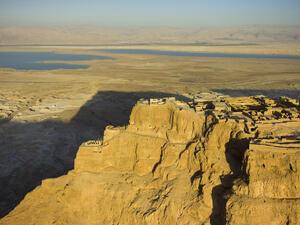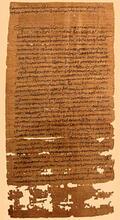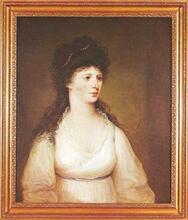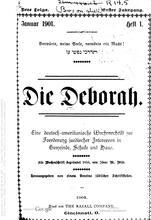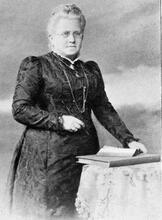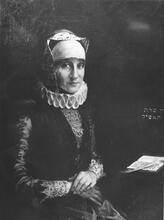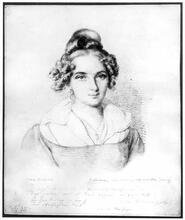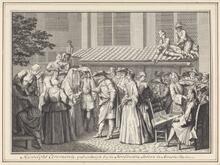Women at Masada
In the first century BCE, Herod the Great built a fortified palace atop the mountain of Masada overlooking the Dead Sea. Seventy years after his death, the First Jewish Revolt against Rome broke out and Jewish rebels occupied Masada. According to the ancient historian Flavius Josephus, three years after the revolt officially ended with the fall of Jerusalem, the Romans besieged Masada—the last Jewish holdout—and the rebels committed mass suicide. At the time of the siege, Masada was occupied by a rag-tag group of 967 men, women, and children according to Josephus. Evidence for the presence of women among the rebels includes various categories of archaeological finds, such as spindle whorls and hair-nets.
Herod the Great, who ruled Judea as client king on behalf of Rome from 40-4 BCE, built a fortified palace atop the mountain of Masada overlooking the Dead Sea. Seventy years after Herod’s death, the First Jewish Revolt against Rome broke out and Jewish rebels occupied Masada. According to the ancient historian Flavius Josephus, three years after the revolt officially ended with the fall of Jerusalem (70 CE), the Romans besieged Masada—the last Jewish holdout— and the rebels committed mass suicide.
Josephus’ Account
According to Josephus, by the time the Romans arrived in 72/73 or 73/74 CE, Masada was occupied by a rag-tag group of 967 men, women, and children. Although we cannot know if Josephus’ number is accurate, discoveries from Yigael Yadin’s 1963-1965 excavations indicate that hundreds of Jews were living on the mountain at the time of the siege.
According to Josephus, Eleazar Ben-Yair, the leader of the rebels, persuaded the men to commit mass suicide by first killing their wives and children. In describing the final moments, Josephus refers repeatedly to wives and children, as for example: “Let us have pity on ourselves, our children and our wives…” (War 7.380; Loeb translation). On the lower terrace of Herod’s northern palace, Yadin discovered the skeletons of a man, a young woman, and a child, which he suggested might belong to the last rebel to commit suicide and his family. The woman’s dark braided hair was preserved intact because of the arid atmosphere, and next to her was a pair of leather sandals. Although scholars debate the historicity of Josephus’ mass suicide story, the physical finds from Yadin’s excavations—including spindle whorls, loom weights, clothing, hair nets, cosmetic items, and inscriptions—confirm the presence of women among the rebels.
Spindle Whorls and Loom Weights
Three hundred and eighty-four spindle whorls were discovered at Masada, mostly from rebel contexts, representing the largest number from any site in Israel. Spindle whorls are small, perforated discs with one flat side that resemble a button made of stone, glass, bone, or wood. A hooked wooden or bone rod called a distaff was inserted through a hole in the center of the whorl. Raw wool or linen was tied to the distaff and then teased out by hand, using the weighted stick (the spindle) to twist the raw material into thread or yarn. In antiquity spinning was done exclusively by women, and the portable nature of spindles allowed the activity to be carried out anywhere.
Like spinning, weaving was carried out exclusively by women. Whereas spinning could be done anywhere, weaving required fixed looms, which were usually located inside houses. In the first century BCE and first century CE, looms had vertical wooden frames (“warp-weighted looms”) to hold wool threads, the ends of which were tied to perforated weights to hold them down. Because they were vertical, warp-weighted looms required the weaver to stand and walk from side to side while working. Approximately 110 loom weights were found at Masada, nearly all from rooms in the casemate (fortification) wall, which were inhabited by the rebels. Whereas Roman loom weights are typically fired, the Masada loom weights are unfired, suggesting they were manufactured on the spot. Because wood for firing the loom weights would have been in short supply atop the mountain, it would have been difficult or impossible to import fired loom weights to Masada during the revolt. The discovery of large numbers of spindle whorls and loom weights at Masada attests to the presence of women among the besieged.
Clothing and Hair Nets
Approximately 2000 textile fragments were discovered at Masada. In the Roman world, everyone wore the same two basic articles of clothing: a tunic and a mantle (cloak). The tunic was similar to a dress or a shift, usually worn with no undergarments. A sleeveless tunic was made by folding a large rectangular sheet and sewing it along the sides, with holes provided for the head and arms. Jewish tunics sometimes were made of two rectangular sheets sewn together at the shoulders, so that if one side became ritually impure it could be removed and replaced without discarding the entire garment. Two parallel narrow stripes descended from the shoulders along the length of the tunic. The stripes, called clavi in Latin, were usually purple in color and indicated the wearer’s status. The length of the tunic varied depending on the wearer’s circumstances, status, and gender. For example, slaves and soldiers wore short tunics (just above the knee) for greater mobility, while women and priests wore long tunics for the purposes of modesty. The tunic’s length could be adjusted by hitching up the cloth over a belt made of cloth, rope, or leather.
The cloak or mantle worn over the tunic typically consisted of a large rectangular sheet, although Roman citizens wore a cloak with a curved hem called a toga. Dark notched bands and gamma-shaped designs were sometimes woven into the corners of mantles worn by both men and women, including Jews. Although color was not confined to women’s clothes, women’s clothing was more likely than men’s to be dyed. Most of the clothing worn by Jews in Roman Judea was made of wool, while priests and male Essenes wore linen.
In many cases it is impossible to determine with certainty the original date or owners of the textiles at Masada. However, it is likely that some fragments of linen clothing and wool tunics with clavi and mantles with notched bands belonged to the rebels, including women, as these are typical articles of clothing worn by Jews in Roman Palestine. Although overall the textiles are of relatively high quality, they display evidence of repeated mending and patching. There are also fragments of a linen sock with a division for the big toe to accommodate a sandal, and a drawstring around the top. The small size suggests it belonged to a child.
Other artifacts found in rebel contexts are associated exclusively with women and therefore attest to female presence. Among the most distinctive are four hair-nets—a rare find. Hair-nets typically were worn with Greek-style (eastern) attire but not with Roman (western) dress and seem to have been standard for Jewish women. All four of the hair-nets are made of wool, and two still had human hairs stuck in them, which indicates that the nets matched the wearer’s hair color: light-colored nets for fair-haired women, and darker nets for dark-haired women. The nets were edged with a braided or woven ribbon sewn along one side of the opening and had a draw-string on the other side that was knotted to the ends of the ribbon. The net was worn by placing the ribbon across the brow, pulling the ends of the draw-string at the base of the nape, and then tying the draw-string around the top of the head.
Cosmetic Items
The casemate wall rooms yielded jewelry and women’s cosmetic items, including a stone palette with two circular depressions on top and a mother-of pearl shell for holding eye color, bronze eye shadow sticks, a bronze mirror case, and tiny ceramic bottles for perfume and kohl (eye liner). The women who owned these items apparently considered them precious enough to carry from their homes to Masada. Among the toiletry items are wooden combs, which were also used by men and children. Like many ancient combs, the Masada examples have fine, closely spaced teeth designed not only to detangle hair but to remove lice and their eggs. This is confirmed by analyses that identified hair lice and eggs still adhering to the teeth of the combs. In addition, a body louse was found in a textile fragment from one of Herod’s storerooms that was occupied at the time of the revolt. Apparently the crowded and unsanitary living conditions bred lice which infested the rebels’ hair and clothing.
Inscriptions
Seven hundred and one inscriptions on ceramic jars and on broken pieces of pottery (ostraca) were discovered in Yadin’s excavations. The inscriptions generally relate to matters of internal administration, particularly the ownership or distribution of food supplies. The vast majority of the inscribed jars and ostraca from Masada are in the Aramaic or Hebrew language and date to the time of the revolt. Women are named or referred to in some of the ostraca, for example, “the wife of [Ze]beida,” “the wife of Jacob,” “the daughter of Domli,” and “Shalom (or Salome) the Galilean.”
One more piece of evidence for female presence at Masada comes from a different location along the Dead Sea: a rugged canyon to the south of Qumran called Wadi Murabba`at. During the First Jewish Revolt and the Bar Kokhba Revolt (132-135 CE), Jews took refuge in caves in this canyon. After the discovery of the first Dead Sea Scrolls, the exploration of the caves yielded finds associated with these refugees, including documents. One is a bill of divorce (Hebrew get), in which “Yehoseph [Joseph] son of Naqsan from… residing in Masada” divorces his wife, Miriam daughter of Yehonathan [Jonathan] from the Nablata, residing in Masada. The get is dated “On the First of Marḥeshvan in the Year Six, at Masada,” that is, 71 CE. This get shows that the rebels at Masada continued to count calendrical years from the beginning of the revolt (66 CE) even after year five, when Jerusalem fell. For this document to have ended up in Wadi Murabba`at, Miriam must have left Masada before the Roman siege began in 72 or 73. Even under these dire circumstances, this Jewish woman apparently sought and was granted a divorce from her husband. The discovery of the get in Wadi Murabba`at indicates that the population at Masada fluctuated, with refugees coming and going until the beginning of the siege. When Miriam departed Masada for Wadi Murabba`at, she took the get with her.
Ben-Tor. Amnon. Back to Masada. Jerusalem: Israel Exploration Society 2009.
Magness, Jodi. Masada: From Jewish Revolt to Modern Myth. Princeton: Princeton University Press, 2019.
Yadin, Yigael. Masada: Herod’s Fortress and the Zealots’ Last Stand. New York: Random House, 1966.

